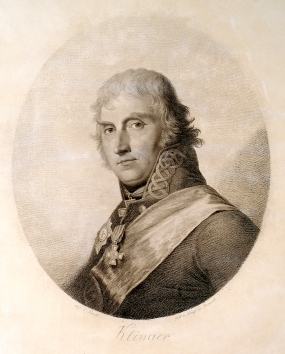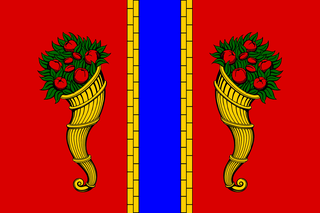
Friedrich Maximilian von Klinger was a German dramatist and novelist. His play Sturm und Drang (1776) gave its name to the Sturm und Drang artistic epoch. He was a childhood friend of Johann Wolfgang von Goethe and is often closely associated with Jakob Michael Reinhold Lenz. Klinger worked as a playwright for the Seylersche Schauspiel-Gesellschaft for two years, but eventually left the Kingdom of Prussia to become a General in the Imperial Russian Army.

The Governorate of Estonia, also known as the Esthonia (Estland) Governorate, was a province (guberniya) and one of the Baltic governorates of the Russian Empire. It was located in the northern Estonia with some islands in the West Estonian archipelago, including Hiiumaa and Vormsi. Previously, the Reval Governorate existed during Peter I's reign and was confirmed by the Treaty of Nystad, which ceded territory from Sweden to the newly established Russian Empire. The Estonia Governorate was established in 1796 when Paul I's reforms abolished the Reval Viceroyalty. The port city of Reval was the administrative centre where the governor had his seat.

The Baltic Governorates, originally the Ostsee Governorates, was a collective name for the administrative units of the Russian Empire set up in the territories of Swedish Estonia, Swedish Livonia (1721) and, afterwards, of the Duchy of Courland and Semigallia (1795).

The modern administrative-territorial structure of Russia is a system of territorial organization which is a product of a centuries-long evolution and reforms.

Anton Friedrich Büsching was a German geographer, historian, educator and theologian. His Erdbeschreibung was the first geographical work of any scientific merit. He also did significant work on behalf of education.

Kingisepp, formerly Yamburg (Я́мбург), Yam (Ям), and Yama, is a town and the administrative center of Kingiseppsky District of Leningrad Oblast, Russia, located along the Luga River 138 kilometers (86 mi) southwest of St. Petersburg, 20 kilometers (12 mi) east of Narva, and 40 kilometers (25 mi) south of the Gulf of Finland. Population: 48,488 (2010 Census); 50,295 (2002 Census); 49,954 (1989 Soviet census).

Vyborg Governorate was an administrative-territorial unit (guberniya) of the Russian Empire. It was established in 1744 in newly ceded territories from Sweden following the Treaty of Åbo and parts of Saint Petersburg Governorate which were previously ceded by Sweden in 1721 as a result of the Great Northern War.

Volosovo is a town and the administrative center of Volosovsky District in Leningrad Oblast, Russia, located on the railway between St. Petersburg and Tallinn, Estonia, 85 kilometers (53 mi) southwest from St. Petersburg. Population: 12,161 (2010 Census); 11,660 (2002 Census); 10,250 (1989 Soviet census).

Johan of Schleswig-Holstein was the youngest son of Frederick II of Denmark and Norway and Sophia of Mecklenburg-Schwerin. He went to Russia in 1602 as the bridegroom of Boris Godunov's daughter Ksenia (Xenia), but fell ill and died before the marriage could take place. It is possible that Boris Godunov's ministers may have poisoned him. The cancelled marriage between John and Ksenia was an attempt to ally Denmark-Norway with the Russian Empire.

Novaya Ladoga is a town in Volkhovsky District of Leningrad Oblast, Russia, located at the point where the Volkhov River flows into Lake Ladoga, 140 kilometers (87 mi) east of St. Petersburg. Population: 8,838 (2010 Census); 9,920 (2002 Census); 11,310 (1989 Soviet census).

Karl Gottlieb von Windisch was a Hungarian German writer who produced a series of letters that were published as "Briefe über den Schachspieler von Kempelen nebst drey Kupferstichen die diese berühmte Maschine vorstellen", translated as "Inanimate Reason; or a Circumstantial Account of That Astonishing Piece of Mechanism, M. de Kempelen's Chess-Player; Now Exhibiting at No. 9 Savile-Row, Burlington Gardens", following a series of performances of The Turk that he attended. The letters have been cited often since their publication in attempts to uncover the secret of the machine. Windisch spoke Slovak and Hungarian and was the first publisher of an academic Journal in Eastern Europe.

Riga Governorate was an administrative-territorial unit (guberniya) and one of the Baltic governorates of the Russian Empire, which existed from 1713 to 1783. The Province of Riga was formed to replace the Eastern Provinces of the Kingdom of Sweden in 1713. After the conquest of the regions of Ingermanland, Livonia and Estonia by Sweden in the Great Northern War in 1710. In 1713, the Provinces of Riga and Tallinn were separated into separate administrative units, and in 1713–1714, the organization and management of the Province of Riga were also defined.

Estonia was under military occupation by the German Empire during the later stages of the First World War. On 11–21 October 1917, the Imperial German Army occupied the West Estonian archipelago, including the larger islands of Saaremaa (Ösel), Hiiumaa (Dagö), and Muhu (Moon).

The following is an alphabetical list of articles related to the Republic of Estonia.
Johann Ernst Fabri was a German geographer and statistician.
Léon d'Ymbault de Vanthay was the last Moldavian mayor of Czernowitz before the annexation of the Bukovina by Austria in 1775.

Kingiseppsky District is an administrative and municipal district (raion), one of the seventeen in Leningrad Oblast, Russia. It is located in the southwest of the oblast and borders with Ida-Viru County of Estonia in the west, Lomonosovsky District in the northeast, Volosovsky District in the east, and with Slantsevsky District in the south. In the north and northwest it is washed by the waters of the Gulf of Finland. The area of the district is 2,908 square kilometers (1,123 sq mi). Its administrative center is the town of Kingisepp. Population : 19,830 (2010 Census); 20,408 ; 34,081 (1989 Soviet census).. Including the entire district: 78,183 (2010 Census);.

Pskov Governorate was an administrative-territorial unit (guberniya) of the Russian Empire and the Russian SFSR, which existed in 1772–1777 and 1796–1927. Its seat was located in Opochka between 1772 and 1776, and in Pskov after 1776. The governorate was located in the west of the Russian Empire and bordered Saint Petersburg Governorate in the north, Novgorod Governorate in the northeast, Tver Governorate in the east, Smolensk Governorate in the southeast, Belarusian Governorate in the south, and Governorate of Livonia in the west.

Voronezh Governorate was an administrative-territorial unit (guberniya) of the Tsardom of Russia, the Russian Empire, and the Russian SFSR, which existed from 1708 to 1779 and again from 1796 to 1928. Its capital was located in Voronezh since 1725.
Yamburgsky Uyezd was one of the eight subdivisions of the Saint Petersburg Governorate of the Russian Empire. Its capital was Yamburg (Kingisepp). Yamburgsky Uyezd was located in the westernmost part of the governorate.

















